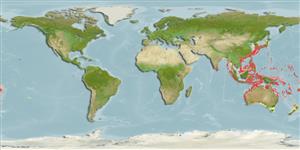Environment: milieu / climate zone / depth range / distribution range
Ecologie
marien demersaal; diepte 85 - 154 m (Ref. 9824). Temperate
Indo-West Pacific: southern Japan to the South China Sea. Also recorded from northwestern Australia (Ref. 5978) and New Caledonia (Ref. 9824).
Grootte / Gewicht / Leeftijd
Maturity: Lm ? range ? - ? cm
Max length : 17.0 cm TL mannelijk / geslacht onbekend; (Ref. 9824)
Dorsale stekels (totaal) : 0; Dorsale zachte stralen (totaal) : 99 - 106; Anale stekels: 0; Anale zachte stralen: 76 - 83. Snout sharp. Maxillary extending to below or beyond middle of lower eye. No gill rakers on upper limb. Cycloid scales on ocular side. Caudal fin having 3 simple upper and lower rays. No dark blotch on pectoral and pelvic fins. Second dorsal fin ray elongated in male.
Inhabits bottoms with broken coral, shell, pebbles, and gray mud. Feeds on bottom-living animals.
Levenscyclus en paargedrag
Maturiteit | Voortplanting | Paaien | Eieren | Fecunditeit | Larven
Masuda, H., K. Amaoka, C. Araga, T. Uyeno and T. Yoshino, 1984. The fishes of the Japanese Archipelago. Vol. 1. Tokai University Press, Tokyo, Japan. 437 p. (text). (Ref. 559)
Status op de Rode Lijst van het IUCN (Ref. 130435: Version 2024-1)
Gevaar voor de mens
Harmless
Gebruik door de mens
Visserij: van geen belang
Tools
Speciale rapporten
Download XML
Internetbronnen
Estimates based on models
Preferred temperature (Ref.
123201): 15.3 - 26.8, mean 21.2 °C (based on 167 cells).
Fylogenetische diversiteitsindex (Ref.
82804): PD
50 = 0.5000 [Uniqueness, from 0.5 = low to 2.0 = high].
Bayesian length-weight: a=0.00741 (0.00394 - 0.01394), b=3.02 (2.86 - 3.18), in cm total length, based on LWR estimates for this species & (Sub)family-body (Ref.
93245).
Trofisch niveau (Ref.
69278): 3.5 ±0.37 se; based on food items.
Weerstandsvermogen (Ref.
120179): Gemiddeld, minimale populatieverdubbelingstijd 1,4-4,4 jaar (Preliminary K or Fecundity.).
Fishing Vulnerability (Ref.
59153): Low vulnerability (10 of 100).
